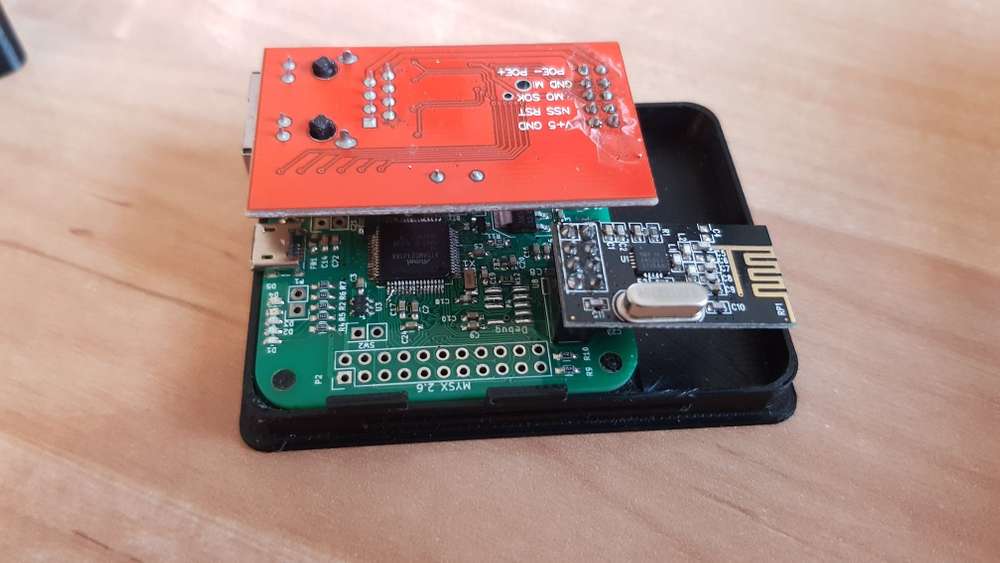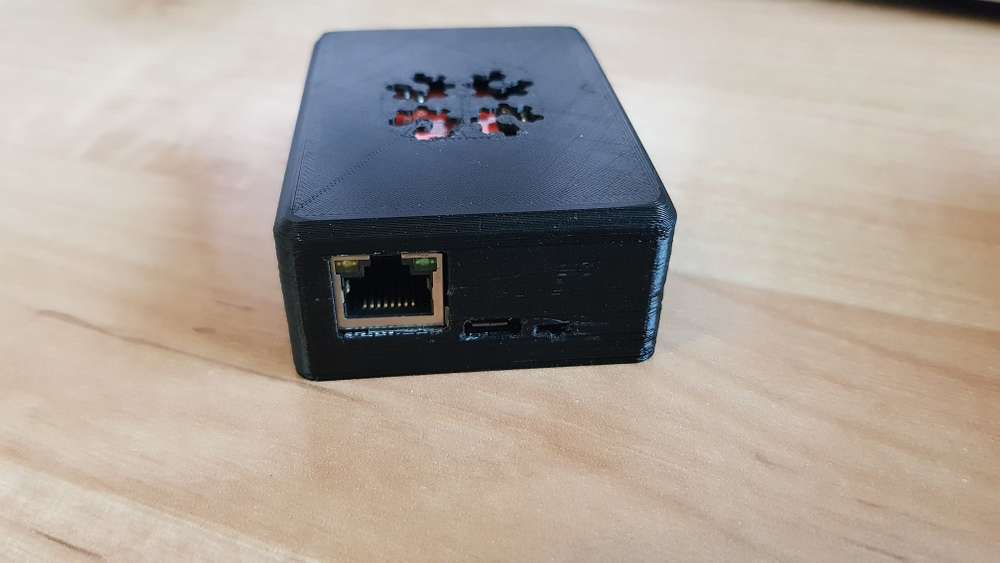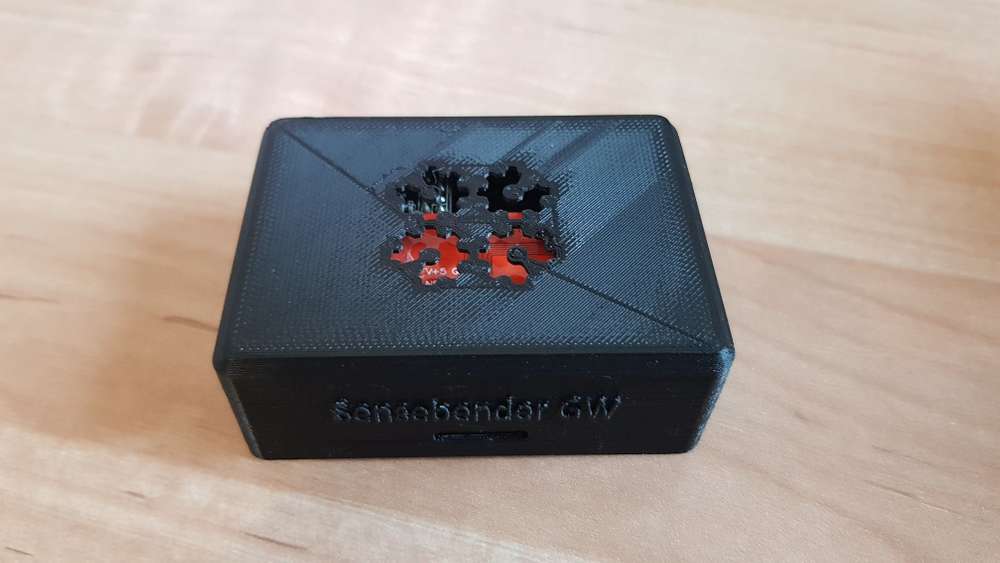for a short moment I was able to connect to the myscontroller and got the following log:
21.01.2019 22:24:41 ERROR ErrorFlag=255, Msg=?^a?
21.01.2019 22:24:41 RX �B�?�$�?]?}?�L?*+2a??MQt҆Ÿ?�Go�?I?�?
21.01.2019 22:24:41 ERROR ErrorFlag=255, Msg=�B�?�$�?]?}?�L?*+2a??MQt҆Ÿ?�Go�?I?�?
21.01.2019 22:24:41 RX
21.01.2019 22:24:41 ERROR ErrorFlag=255, Msg=
21.01.2019 22:24:41 RX ?�?z?�?xQG&F⎙(݄???¢�
21.01.2019 22:24:41 ERROR ErrorFlag=255, Msg=?�?z?�?xQG&F⎙(݄???¢�
21.01.2019 22:24:41 RX ??`???i?Ŀ�?^a?Hf?�???�wHH?h?Gb؛??�W?U��Y?�?
21.01.2019 22:24:41 ERROR ErrorFlag=255, Msg=??`???i?Ŀ�?^a?Hf?�???�wHH?h?Gb؛??�W?U��Y?�?
21.01.2019 22:24:41 RX Ⱥ?x)ل?c??
21.01.2019 22:24:41 ERROR ErrorFlag=255, Msg=Ⱥ?x)ل?c??
21.01.2019 22:24:41 RX ?R]hgGR�?r���7"��?JOS?-�&?{?�?%?~?s??ɋ5??.Ejj?7?�er?8?P?�1�@T?s{?\G�$
21.01.2019 22:24:41 ERROR ErrorFlag=255, Msg=?R]hgGR�?r���7"��?JOS?-�&?{?�?%?~?s??ɋ5??.Ejj?7?�er?8?P?�1�@T?s{?\G�$
21.01.2019 22:24:41 RX "'??
?12??�?�9?7˩/9[u?u?�[?�6Z
???{#�|X|M?�?�4!?GB?8??b̨??۽?x?v??Ar?/?m'!n"
21.01.2019 22:24:41 ERROR "ErrorFlag=255, Msg='??
?12??�?�9?7˩/9[u?u?�[?�6Z
???{#�|X|M?�?�4!?GB?8??b̨??۽?x?v??Ar?/?m'!n"
21.01.2019 22:24:41 RX ?c?b?-
21.01.2019 22:24:41 ERROR ErrorFlag=255, Msg=?c?b?-
21.01.2019 22:24:41 RX eH�{??J6
21.01.2019 22:24:41 ERROR ErrorFlag=255, Msg=eH�{??J6
21.01.2019 22:24:41 RX 5[?�4??*�?�j��????ql�??5
21.01.2019 22:24:41 ERROR ErrorFlag=255, Msg=5[?�4??*�?�j��????ql�??5
21.01.2019 22:24:41 RX ">?�/??]J?�v�@�;jL!F??�?�??>?�??TX?B# ?n??� ?O?�}?8?ǀ�???
T?0y1?U�??/?H?Lj?��*ߋ8t�??#7pY�??""&O??r? ?p?7?�?�ļ_^??>?+*??ҖP�R???Cz?!f?:�&~z?Hӑ"
21.01.2019 22:24:41 ERROR "ErrorFlag=255, Msg=>?�/??]J?�v�@�;jL!F??�?�??>?�??TX?B# ?n??� ?O?�}?8?ǀ�???
T?0y1?U�??/?H?Lj?��*ߋ8t�??#7pY�??""&O??r? ?p?7?�?�ļ_^??>?+*??ҖP�R???Cz?!f?:�&~z?Hӑ"
21.01.2019 22:24:41 RX ?�:?�E??I????
21.01.2019 22:24:41 ERROR ErrorFlag=255, Msg=?�:?�E??I????
21.01.2019 22:24:41 RX "?,�T?$?f8\?^?�o
?݈s?�?P)?F??W ?Z':?`q??y?<??\F駐???<??0?DȅΠ?BZ_?!gB??"
21.01.2019 22:24:41 ERROR "ErrorFlag=255, Msg=?,�T?$?f8\?^?�o
?݈s?�?P)?F??W ?Z':?`q??y?<??\F駐???<??0?DȅΠ?BZ_?!gB??"
21.01.2019 22:24:41 RX "?�?""
??i32٫+?m??�{p?<�H?^>�'bl?\?\?h?�??ځ{?C"
21.01.2019 22:24:41 ERROR "ErrorFlag=255, Msg=?�?""
??i32٫+?m??�{p?<�H?^>�'bl?\?\?h?�??ځ{?C"
21.01.2019 22:24:41 RX ??4??(3A�X?Hb?[k?؊??iT?6
21.01.2019 22:24:41 ERROR ErrorFlag=255, Msg=??4??(3A�X?Hb?[k?؊??iT?6
21.01.2019 22:24:41 RX "??A??,??*�?�?ab!?^�3l=?�??[�M3??lay?f9B??��J?8G?C?�}JOU?%
�Tǽ?I/h???\�
��4b%<��??!AH??kw�??^?�"
21.01.2019 22:24:41 ERROR "ErrorFlag=255, Msg=??A??,??*�?�?ab!?^�3l=?�??[�M3??lay?f9B??��J?8G?C?�}JOU?%
�Tǽ?I/h???\�
��4b%<��??!AH??kw�??^?�"
21.01.2019 22:24:41 RX ?��9??H ?Y0?*?aͧ?Z.!?p2�P??
21.01.2019 22:24:41 ERROR ErrorFlag=255, Msg=?��9??H ?Y0?*?aͧ?Z.!?p2�P??
21.01.2019 22:24:41 RX "f?>;???0f�??iB*�}?/?J�*1��?~?S����6�WjH.?w? ?K#?29?(?kq8-O?V?�?U?n\"
21.01.2019 22:24:41 ERROR "ErrorFlag=255, Msg=f?>;???0f�??iB*�}?/?J�*1��?~?S����6�WjH.?w? ?K#?29?(?kq8-O?V?�?U?n\"
21.01.2019 22:24:41 RX ?^a?
21.01.2019 22:24:41 ERROR ErrorFlag=255, Msg=?^a?
21.01.2019 22:24:41 RX �B�?�$�?]?}?�L?*+2a??MQt҆Ÿ?�Go�?I?�?
21.01.2019 22:24:41 ERROR ErrorFlag=255, Msg=�B�?�$�?]?}?�L?*+2a??MQt҆Ÿ?�Go�?I?�?
21.01.2019 22:24:41 RX
21.01.2019 22:24:41 ERROR ErrorFlag=255, Msg=
21.01.2019 22:24:41 RX ?�?z?�?xQG&F⎙(݄???¢�
21.01.2019 22:24:41 ERROR ErrorFlag=255, Msg=?�?z?�?xQG&F⎙(݄???¢�
21.01.2019 22:24:41 RX ??`???i?Ŀ�?^a?Hf?�???�wHH?h?Gb؛??�W?U��Y?�?
21.01.2019 22:24:41 ERROR ErrorFlag=255, Msg=??`???i?Ŀ�?^a?Hf?�???�wHH?h?Gb؛??�W?U��Y?�?
21.01.2019 22:24:41 RX Ⱥ?x)ل?c??
21.01.2019 22:24:41 ERROR ErrorFlag=255, Msg=Ⱥ?x)ل?c??
21.01.2019 22:24:41 RX ?R]hgGR�?r���7"��?JOS?-�&?{?�?%?~?s??ɋ5??.Ejj?7?�er?8?P?�1�@T?s{?\G�$
21.01.2019 22:24:41 ERROR ErrorFlag=255, Msg=?R]hgGR�?r���7"��?JOS?-�&?{?�?%?~?s??ɋ5??.Ejj?7?�er?8?P?�1�@T?s{?\G�$
21.01.2019 22:24:41 RX "'??
?12??�?�9?7˩/9[u?u?�[?�6Z
???{#�|X|M?�?�4!?GB?8??b̨??۽?x?v??Ar?/?m'!n"
21.01.2019 22:24:41 ERROR "ErrorFlag=255, Msg='??
?12??�?�9?7˩/9[u?u?�[?�6Z
???{#�|X|M?�?�4!?GB?8??b̨??۽?x?v??Ar?/?m'!n"
21.01.2019 22:24:41 RX ?c?b?-
21.01.2019 22:24:41 ERROR ErrorFlag=255, Msg=?c?b?-
21.01.2019 22:24:41 RX eH�{??J6
21.01.2019 22:24:41 ERROR ErrorFlag=255, Msg=eH�{??J6
21.01.2019 22:24:41 RX 5[?�4??*�?�j��????ql�??5
21.01.2019 22:24:41 ERROR ErrorFlag=255, Msg=5[?�4??*�?�j��????ql�??5
21.01.2019 22:24:41 RX ">?�/??]J?�v�@�;jL!F??�?�??>?�??TX?B# ?n??� ?O?�}?8?ǀ�???
T?0y1?U�??/?H?Lj?��*ߋ8t�??#7pY�??""&O??r? ?p?7?�?�ļ_^??>?+*??ҖP�R???Cz?!f?:�&~z?Hӑ"
21.01.2019 22:24:41 ERROR "ErrorFlag=255, Msg=>?�/??]J?�v�@�;jL!F??�?�??>?�??TX?B# ?n??� ?O?�}?8?ǀ�???
T?0y1?U�??/?H?Lj?��*ߋ8t�??#7pY�??""&O??r? ?p?7?�?�ļ_^??>?+*??ҖP�R???Cz?!f?:�&~z?Hӑ"
21.01.2019 22:24:41 RX ?�:?�E??I????
21.01.2019 22:24:41 ERROR ErrorFlag=255, Msg=?�:?�E??I????
21.01.2019 22:24:41 RX "?,�T?$?f8\?^?�o
?݈s?�?P)?F??W ?Z':?`q??y?<??\F駐???<??0?DȅΠ?BZ_?!gB??"
21.01.2019 22:24:41 ERROR "ErrorFlag=255, Msg=?,�T?$?f8\?^?�o
?݈s?�?P)?F??W ?Z':?`q??y?<??\F駐???<??0?DȅΠ?BZ_?!gB??"
21.01.2019 22:24:41 RX "?�?""
??i32٫+?m??�{p?<�H?^>�'bl?\?\?h?�??ځ{?C"
21.01.2019 22:24:41 ERROR "ErrorFlag=255, Msg=?�?""
??i32٫+?m??�{p?<�H?^>�'bl?\?\?h?�??ځ{?C"
21.01.2019 22:24:41 RX ??4??(3A�X?Hb?[k?؊??iT?6
21.01.2019 22:24:41 ERROR ErrorFlag=255, Msg=??4??(3A�X?Hb?[k?؊??iT?6
21.01.2019 22:24:41 RX "??A??,??*�?�?ab!?^�3l=?�??[�M3??lay?f9B??��J?8G?C?�}JOU?%
�Tǽ?I/h???\�
��4b%<��??!AH??kw�??^?�"
21.01.2019 22:24:41 ERROR "ErrorFlag=255, Msg=??A??,??*�?�?ab!?^�3l=?�??[�M3??lay?f9B??��J?8G?C?�}JOU?%
�Tǽ?I/h???\�
��4b%<��??!AH??kw�??^?�"
21.01.2019 22:24:41 RX ?��9??H ?Y0?*?aͧ?Z.!?p2�P??
21.01.2019 22:24:41 ERROR ErrorFlag=255, Msg=?��9??H ?Y0?*?aͧ?Z.!?p2�P??
21.01.2019 22:24:41 RX "f?>;???0f�??iB*�}?/?J�*1��?~?S����6�WjH.?w? ?K#?29?(?kq8-O?V?�?U?n\"
21.01.2019 22:24:41 ERROR "ErrorFlag=255, Msg=f?>;???0f�??iB*�}?/?J�*1��?~?S����6�WjH.?w? ?K#?29?(?kq8-O?V?�?U?n\"
21.01.2019 22:24:41 RX ?^a?
21.01.2019 22:24:41 ERROR ErrorFlag=255, Msg=?^a?
21.01.2019 22:24:41 RX �B�?�$�?]?}?�L?*+2a??MQt҆Ÿ?�Go�?I?�?
21.01.2019 22:24:41 ERROR ErrorFlag=255, Msg=�B�?�$�?]?}?�L?*+2a??MQt҆Ÿ?�Go�?I?�?
21.01.2019 22:24:41 RX
21.01.2019 22:24:41 ERROR ErrorFlag=255, Msg=
21.01.2019 22:24:41 RX ?�?z?�?xQG&F⎙(݄???¢�
21.01.2019 22:24:41 ERROR ErrorFlag=255, Msg=?�?z?�?xQG&F⎙(݄???¢�
21.01.2019 22:24:41 RX ??`???i?Ŀ�?^a?Hf?�???�wHH?h?Gb؛??�W?U��Y?�?
21.01.2019 22:24:41 ERROR ErrorFlag=255, Msg=??`???i?Ŀ�?^a?Hf?�???�wHH?h?Gb؛??�W?U��Y?�?
21.01.2019 22:24:41 RX Ⱥ?x)ل?c??
21.01.2019 22:24:41 ERROR ErrorFlag=255, Msg=Ⱥ?x)ل?c??
21.01.2019 22:24:41 RX ?R]hgGR�?r���7"��?JOS?-�&?{?�?%?~?s??ɋ5??.Ejj?7?�er?8?P?�1�@T?s{?\G�$
21.01.2019 22:24:41 ERROR ErrorFlag=255, Msg=?R]hgGR�?r���7"��?JOS?-�&?{?�?%?~?s??ɋ5??.Ejj?7?�er?8?P?�1�@T?s{?\G�$
21.01.2019 22:24:41 RX "'??
?12??�?�9?7˩/9[u?u?�[?�6Z
???{#�|X|M?�?�4!?GB?8??b̨??۽?x?v??Ar?/?m'!n"
21.01.2019 22:24:41 ERROR "ErrorFlag=255, Msg='??
?12??�?�9?7˩/9[u?u?�[?�6Z
???{#�|X|M?�?�4!?GB?8??b̨??۽?x?v??Ar?/?m'!n"
can it be that the nano has too little power (+5V) for the NRF and W5100 when I feed it via USB?




